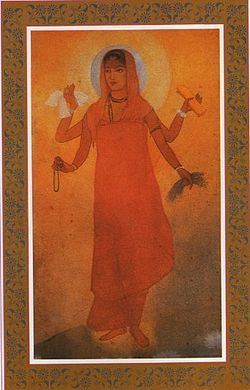Year 1905 Artist Abanindranath Tagore Media Watercolor painting | Type Watercolor painting Created 1905 | |
 | ||
Similar The Passing of Shah Jah, Shakuntala, Bride's Toilet, Three Girls, A Moonlight Music Party | ||
Baba satyanarayan mourya bharat mata painting lucknow
Bharat Mata is an epic painting by celebrated Indian painter, Abanindranath Tagore.
Contents
Bharat Mata, Abanindranath Tagore’s work dating back to 1905, depicts a saffron clad woman, in the dress of a Hindu sadhvi, holding a book, sheaves of paddy, a piece of white cloth and a garland in her four hands. The painting is also considered significant because of its historical value and since it had helped in conceptualizing the idea of Bharat Mata ("Mother India").
“The painting is an attempt of humanisation of ‘Bharat Mata’ where the mother is seeking liberation through her sons.” Historians state that Sister Nivedita, an admirer of the painting, wanted to carry it from Jammu and Kashmir to Kanyakumari to spread nationalist fervour among the people of the country.
Nephew of Nobel laureate Rabindranath Tagore, Abanindranath is considered the foundational figure of the Bengal School of Art and is also hailed as the "father of modern Indian art".
Experts say that Abanindranath Tagore reinvented Rajput and Mughal miniature painting from the influence of western models of art.
The painting depicts Bharat Mata, the deified form of India venerated historically as well as contemporarily throughout the nation.
Bharat mata ki jai
The Painting
Abanindranath Tagore painted Banga Mata (Bengali for Bharat Mata) as the Lakshmi Devi, the Hindu Goddess of Plenty, clad in the apparel of a Vaishnava renunciant.
